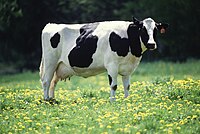
Photo from wikipedia
The aim of this study was to describe metabolism of early-lactation dairy cows by clustering cows based on glucose, insulin-like growth factor I (IGF-I), free fatty acid, and β-hydroxybutyrate (BHB)… Click to show full abstract
The aim of this study was to describe metabolism of early-lactation dairy cows by clustering cows based on glucose, insulin-like growth factor I (IGF-I), free fatty acid, and β-hydroxybutyrate (BHB) using the k-means method. Predictive models for metabolic clusters were created and validated using 3 sets of milk biomarkers (milk metabolites and enzymes, glycans on the immunogamma globulin fraction of milk, and Fourier-transform mid-infrared spectra of milk). Metabolic clusters are used to identify dairy cows with a balanced or imbalanced metabolic profile. Around 14 and 35 d in milk, serum or plasma concentrations of BHB, free fatty acids, glucose, and IGF-I were determined. Cows with a favorable metabolic profile were grouped together in what was referred to as the "balanced" group (n = 43) and were compared with cows in what was referred to as the "other balanced" group (n = 64). Cows with an unfavorable metabolic profile were grouped in what was referred to as the "imbalanced" group (n = 19) and compared with cows in what was referred to as the "other imbalanced" group (n = 88). Glucose and IGF-I were higher in balanced compared with other balanced cows. Free fatty acids and BHB were lower in balanced compared with other balanced cows. Glucose and IGF-I were lower in imbalanced compared with other imbalanced cows. Free fatty acids and BHB were higher in imbalanced cows. Metabolic clusters were related to production parameters. There was a trend for a higher daily increase in fat- and protein-corrected milk yield in balanced cows, whereas that of imbalanced cows was higher. Dry matter intake and the daily increase in dry matter intake were higher in balanced cows and lower in imbalanced cows. Energy balance was continuously higher in balanced cows and lower in imbalanced cows. Weekly or twice-weekly milk samples were taken and milk metabolites and enzymes (milk glucose, glucose-6-phosphate, BHB, lactate dehydrogenase, N-acetyl-β-d-glucosaminidase, isocitrate), immunogamma globulin glycans (19 peaks), and Fourier-transform mid-infrared spectra (1,060 wavelengths reduced to 15 principal components) were determined. Milk biomarkers with or without additional cow information (days in milk, parity, milk yield features) were used to create predictive models for the metabolic clusters. Accuracy for prediction of balanced (80%) and imbalanced (88%) cows was highest using milk metabolites and enzymes combined with days in milk and parity. The results and models of the present study are part of the GplusE project and identify novel milk-based phenotypes that may be used as predictors for metabolic and performance traits in early-lactation dairy cows.
Journal Title: Journal of dairy science
Year Published: 2019
Link to full text (if available)
Share on Social Media: Sign Up to like & get
recommendations!